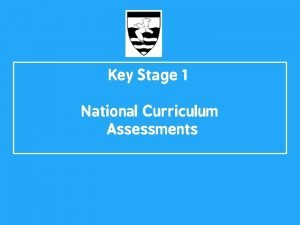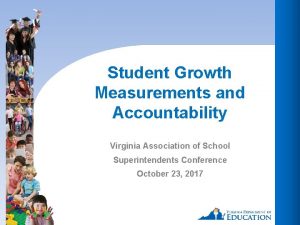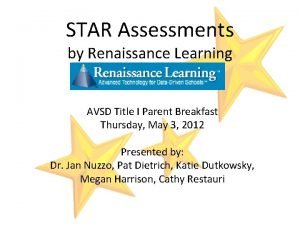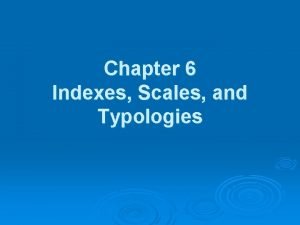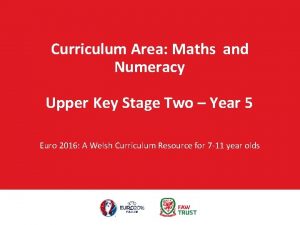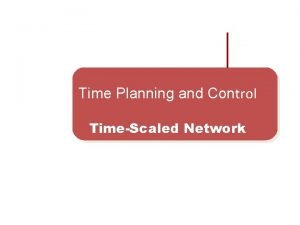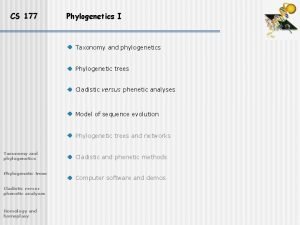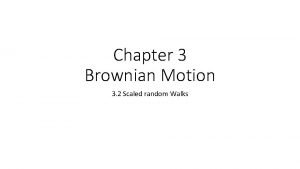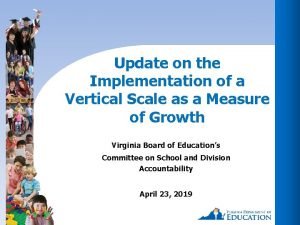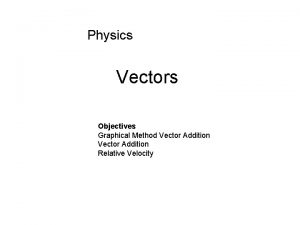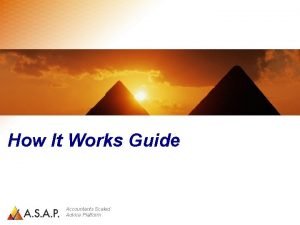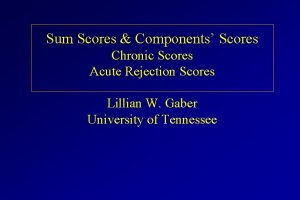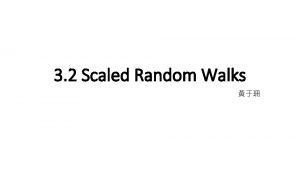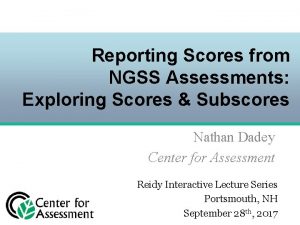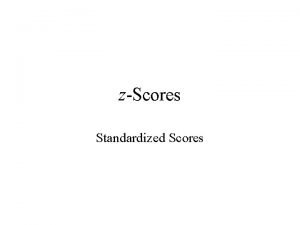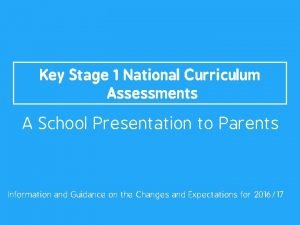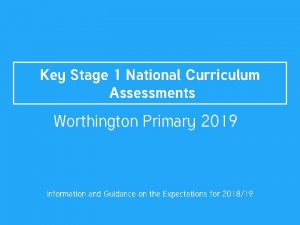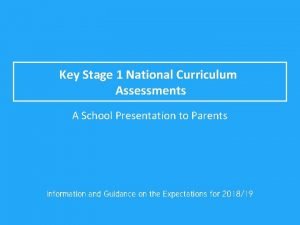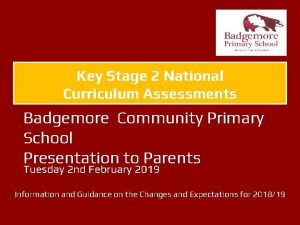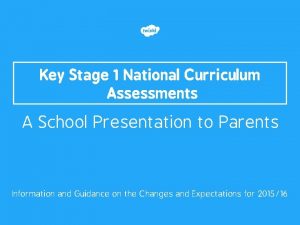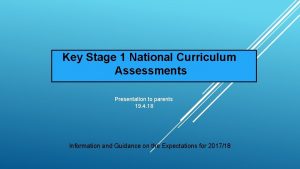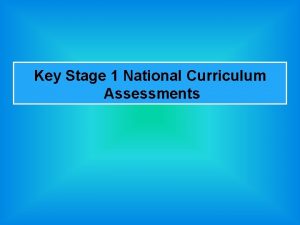Key Stage 1 National Curriculum Assessments Scaled Scores














- Slides: 14

Key Stage 1 National Curriculum Assessments

Scaled Scores • From 2016, test scores are reported as ‘scaled scores’. What is meant by ‘scaled scores’? • It is planned that 100 will always represent the ‘national standard’. • Each pupil’s raw test score will therefore be converted into a score on the scale, either at, above or below 100. • • Each pupil’s raw test score will therefore be converted into a The scale will have a lower end point somewhere below 100 and an upper end scoreabove on the point 100. scale, either at, above or below 100. • A child who achieves the ‘national standard’ (a score of 100) will be judged to • The pupils’ raw sufficient scores are converted into assessed scaled scores to see have demonstrated knowledge in the areas by the tests. whether each pupil has met the national standard in the test.

Scaled Score Examples On publication of the test results in July 2016: child awarded a scaled of 100 is judged have • • A A child awarded a scaled score of score 100 is judged to have met theto ‘national standard’ in the area judged by the test. the ‘national standard’ in the met • A child awarded a scaled score of more than 100 is judged to have exceeded national standard and demonstrated a higher expected • the A child awarded a scaled score of morethan 100 isknowledge judged of to the curriculum for their age. • have exceeded the national standard and demonstrated a A child awarded a scaled score of less thanof 100 the is judged to have not met higher than expected knowledge curriculum foryet their the national standard and performed below expectation for their age. • Marking guidance for KS 1 tests will include conversion tables. Teachers will use to translate pupil’s raw scores into scaled scores to see whether each • these A child awarded a scaled score of less is judged pupil has met the national standard. Teachers will than use the 100 scaled scores toto inform teacher assessment judgements. have their not yet met the national standard and performed below expectation for their age. • These results are used to inform the Teacher Assessments.

End of Key Stage Report On publication of the test results in July 2016: andofmaths, the to Teacher • • A For child reading, awarded awriting scaled score 100 is judged have met. Assessment the ‘national standard’ the areaon judged the test. report. will beinshown yourbychild’s • A child awarded a scaled score of more than 100 is judged to have exceeded national standard demonstrated a higher ‘working than expected • the‘Working at theand expected standard’, at knowledge greater of the curriculum for their age. • depth within the expected standard’ or ‘working towards A the child expected awarded a scaled score of less than 100 is judged to have not yet met standard’. the national standard and performed below expectation for their age. • • Marking guidance for score KS 1 tests willnot include Teachers willbut use The scaled SATs will beconversion includedtables. on the report, these to translate pupil’s raw scores into scaled scores to see whether each mayhas bemet requested the parent / carer. pupil the nationalby standard. Teachers will use the scaled scores to inform their teacher assessment judgements.

The Tests At the end of Year 2, children will 2, take SATS in: will take assessments in: Towards the end of Year children • Reading; • • Reading English grammar, punctuation and spelling; Maths. • • Maths The tests are due to take place in May of each year. • Optional SATs Tests in English grammar, punctuation and spelling will not be taking place. The tests take place in May. (We call them ‘quizzes’)

Reading The consists of two papers: The Reading. Test consists of separate two separate • Paper a selection of texts between 400 and 700 with questions Paper 11––Contains a selection of totalling texts totalling 400 words and 700 words about the text. with questions • Paper Contains a reading booklet of a selection of passages totalling 800 totalling to 1100 800 words. Paper 22– – Contains a reading booklet of a selection of passages to Children will write their answers to questions about the passage in aabout separate 1100 words. Children will write their answers to questions thebooklet. passage in a separate booklet. • Each paper is worth 50% of the marks and should take approximately 30 – 40 minutes to although the 50% children are not being assessed working at speed so will be • complete, Each paper is worth of the marks and shouldattake approximately 30 not minutes strictly timed. although the children are not being assessed at working at speed to complete, so will not be strictly timed. • The texts will cover a range of poetry, fiction and non-fiction. • Questions are designed to assess the comprehension and understanding of a child’s reading. • Questions are designed to assess the comprehension and understanding of a • Some child’squestions reading. are multiple choice or selected response, others require short answers and some require an extended response or explanation. • Some questions are multiple choice or selected response, others require short answers and some require an extended response or explanation.

Mathematics twotests: Paper 1 1 and and. Paper 2: 2: Children will sit two • • • Paper 1 is for arithmetic, lasting approximately 25 minutes and worth 25 marks. It covers methods forapproximately all operations. 25 minutes and worth 25 marks. Paper 1 iscalculation for arithmetic, lasting It covers calculation methods for all operations. Paper 2 covers problem solving, reasoning and mathematical fluency, lasts for approximately 35 minutes and is worth 35 marks. • Paper 2 covers problem solving, reasoning and mathematical fluency, lasts for 35 minutes and is worth 35 marks. • approximately Pupils will still require calculation skills and questions will be varied including • multiple choice, matching, true/false, completing a chart or table or drawing a shape. will Some will also require children to show or varied explainincluding their Pupils stillquestions require calculation skills and questions will be working choice, out. multiple matching, true/false, completing a chart or table or drawing a shape. Some questions will also require children to show or explain their working out.

Sample Questions Maths Paper 1: Arithmetic

Sample Questions Maths Paper 2: Reasoning

How to Help Your Child First and reassure your child that there is nothing to • • First andforemost, support and reassure your is nothing worry about and that they should always just try their best. Praise and to worry about and that they should always just try their best. Praise and encourage! • Ensure your child has the best possible attendance at school. • Support your child with any homework tasks. • • Support child all homework tasks. Reading, your spelling andwith arithmetic (e. g. times tables) are always good to practise. Talk tothe your child about that whatcome they have learnt school andand what book(s) they • • Read new targets home eachathalf term work on these are reading (the character, the plot, their opinion). whenever you can. • Make sure your child has a good sleep and healthy breakfast every morning! • Ask your child’s class teacher if you are unsure. • Make sure your child has a good sleep and healthy breakfast every morning!

How to Help Your Child with Reading your child readcan cantakemanyforms: Listening to your • First and foremost, focus developing an enjoyment and love of reading. • Enjoy stories together – reading stories to your child is equally as important as listening to your child read. • Enjoy stories together – reading stories to your child is equally as important as to your • listening Read a little at achild time read. but often, rather than rarely but for long periods of time! • Read five times a week for 5 during minutes. Talk about the story before, and afterwards – discuss the plot, the characters, their feelings and actions, how it makes you feel, predict what will andisencourage child have to have their opinions. • happen All reading valuable – your it doesn’t to be justown stories. Reading can involve anything from fiction and non-fiction, poetry, newspapers, magazines, football • Look up definitions of words together – you could use a dictionary, the Internet or programmes, TV guides. an app on a phone or tablet. • • Visit the local library - it’s All reading is valuable – itfree! doesn’t have to be just stories. Reading can involve anything from fiction and non-fiction, poetry, newspapers, magazines, football programmes, TV guides. • Visit the local library - it’s free!

How to Help Your Child with Writing • • Practise lists – make fun! Practise andlearnweeklyspelling lists for 10 it minutes a week – make it fun • Encourage opportunities for writing, such as letters to family or friends, shopping lists, notes or reminders, stories or poems. • Encourage opportunities for writing, such as letters to family or friends, • Write together be a or good role modelstories for writing. shopping lists, –notes reminders, or poems. • Encourage use of a dictionary to check spelling. • Write together – be a good role model for writing. • Allow your child to use a computer for word processing, which will allow for and correcting of errors without of crossing out. • editing Encourage use of a dictionary to checklots spelling. • Remember that good readers become good writers! Identify good writing • Show your appreciation: and encourage, even forpunctuation). small successes! features when reading (e. g. praise vocabulary, sentence structure, • Show your appreciation: praise and encourage, even for small successes!

How to Help Your Child with Maths Playtheir timeshomework tables games. • • Do with them for 5 minutes 5 times a week. • Play mental maths games including counting in different amounts, forwards and • Play times tables games. backwards. Encourage opportunities forfor telling the time. • • Encourage opportunities telling • Encourage opportunities for counting coins and money e. g. finding amounts or • Encourage opportunities for counting coins and money e. g. finding calculating change when shopping. amounts or calculating change when shopping. • Look for numbers on street signs, car registrations and anywhere else. • Weigh or measure quantities and amounts in the kitchen or in recipes. • Look for examples of 2 D and 3 D shapes around the home. • Identify, weigh or measure quantities and amounts in the kitchen or in recipes. • Play games involving numbers or logic, such as dominoes, card games, draughts or chess.

Thank-you for listening. Any questions?
 Key stage 1 scaled scores
Key stage 1 scaled scores Vdoe vertical scaled score
Vdoe vertical scaled score Star enterprise scaled scores
Star enterprise scaled scores Typologies are nominal composite measures
Typologies are nominal composite measures Upper key stage 2 maths
Upper key stage 2 maths Key activities business model
Key activities business model Key partners key activities key resources
Key partners key activities key resources Time scaled network diagram
Time scaled network diagram The-horror-of-the-scaled-agile-framework
The-horror-of-the-scaled-agile-framework Meaning of microteaching
Meaning of microteaching Scaled vs unscaled phylogenetic tree
Scaled vs unscaled phylogenetic tree Scaled random walk
Scaled random walk Vertical scaled score virginia growth assessment
Vertical scaled score virginia growth assessment Graphical method vector addition
Graphical method vector addition What is scaled advice
What is scaled advice
